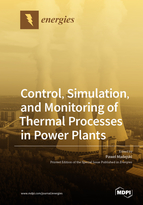Control, Simulation, and Monitoring of Thermal Processes in Power Plants
A special issue of Energies (ISSN 1996-1073). This special issue belongs to the section "J: Thermal Management".
Deadline for manuscript submissions: closed (25 July 2022) | Viewed by 42295
Special Issue Editor
Interests: thermal power engineering; power plants; computational fluid dynamics; engineering thermodynamics; steam boilers and heat exchangers; power plant simulation; engineering thermofluids
Special Issues, Collections and Topics in MDPI journals
Special Issue Information
Dear Colleagues,
The thermal processes have a significant impact on the performances and the energy conversion efficiencies in power plants and combined heat and power plants. The constant pursuit of increasing power output and energy generation efficiency requires higher thermal conditions of the working medium. Extending the load range and ensuring the flexible power plant operation may generate rapid and unpredictable changes in thermal operating conditions. Only the proper design, monitoring, and control of thermal processes reduce the risk of machinery and equipment failure keeping the high overall process efficiency. It requires the implementation of advanced materials and novel techniques for the control and monitoring of thermal processes. Mathematical models and simulation results are one of the most useful and low-cost solutions that can be used in the design and monitoring of thermal processes.
Investigations of many researchers all over the world are focused on thermal processes control in power plants to keep a high efficiency, reduce the number of failures, and extend the components lifetime.
This Special Issue aims to cover the recent research results being developed numerically and experimentally, on the laboratory scale, the pilot, and the industrial scale. The research investigation results of thermal processes can find implementation in real scale power technologies like steam power plants, gas power plants, nuclear power plants, and power plants based on renewable energy sources. These investigations include, in particular, but not exclusively:
- control and monitoring of thermal processes in power plant
- efficiency of thermal-flow and combustion processes in energy technologies
- modeling and simulation of power plant
- power plant system, machines, and devices
- techno-economic analysis of power plant operation
Prof. Dr. Pawel Madejski
Guest Editor
Manuscript Submission Information
Manuscripts should be submitted online at www.mdpi.com by registering and logging in to this website. Once you are registered, click here to go to the submission form. Manuscripts can be submitted until the deadline. All submissions that pass pre-check are peer-reviewed. Accepted papers will be published continuously in the journal (as soon as accepted) and will be listed together on the special issue website. Research articles, review articles as well as short communications are invited. For planned papers, a title and short abstract (about 100 words) can be sent to the Editorial Office for announcement on this website.
Submitted manuscripts should not have been published previously, nor be under consideration for publication elsewhere (except conference proceedings papers). All manuscripts are thoroughly refereed through a single-blind peer-review process. A guide for authors and other relevant information for submission of manuscripts is available on the Instructions for Authors page. Energies is an international peer-reviewed open access semimonthly journal published by MDPI.
Please visit the Instructions for Authors page before submitting a manuscript. The Article Processing Charge (APC) for publication in this open access journal is 2600 CHF (Swiss Francs). Submitted papers should be well formatted and use good English. Authors may use MDPI's English editing service prior to publication or during author revisions.
Keywords
- Thermal power plants
- Supercritical and ultra-supercritical power plants
- Cogeneration and poligeneration systems
- Flexible operation of power plants
- Power plant modeling and simulation
- Steam generators and heat exchangers
- Fouling and failures during thermal processes
- Steam and gas turbines
- Thermal-hydraulic processes
- Computational fluid dynamics
- Mathematical modeling in power engineering
- Combustion and heat transfer in power engineering
- Techno-economic analysis of thermal power plant
- Advanced materials for thermal power plant technologies






